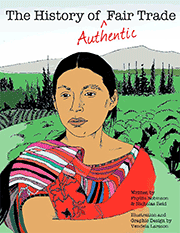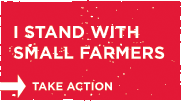 If you shop at your local food co-op, Whole Foods, or a number of other natural food grocery stores you have probably seen this label. One of the newest seals in the marketplace, this one attempts to assure shoppers that the product does not contain GMOs (Genetically Modified Organisms). Unlike the mandatory GMO labeling laws which a number of states have been trying to pass at the polls, this initiative is seemingly noncontroversial. Who can find fault with the pretty butterfly hanging out in nature’s green pastures? Who could argue with an initiative that lets you know that the product is a wholesome choice for you and your family? Yet, what and who are really behind this initiative? Is it as pure and wholesome as the image and the colors of the blue sky and the green pastures would have us believe?
If you shop at your local food co-op, Whole Foods, or a number of other natural food grocery stores you have probably seen this label. One of the newest seals in the marketplace, this one attempts to assure shoppers that the product does not contain GMOs (Genetically Modified Organisms). Unlike the mandatory GMO labeling laws which a number of states have been trying to pass at the polls, this initiative is seemingly noncontroversial. Who can find fault with the pretty butterfly hanging out in nature’s green pastures? Who could argue with an initiative that lets you know that the product is a wholesome choice for you and your family? Yet, what and who are really behind this initiative? Is it as pure and wholesome as the image and the colors of the blue sky and the green pastures would have us believe?
Equal Exchange has of course been asked by some of our customers why we have not chosen to put this seal on our products (which are all free of GMOs). In order to educate ourselves, and our consumers, we have delved into the issue to better understand how this initiative came to be and who it potentially benefits and harms. After our latest lively discussion, several of our sales representatives were particularly motivated to do further research into different aspects of the issue. This week we will feature those opinion pieces.
Today, we hear from Jenica Rosen, sales representative, based in our Portland, Oregon office:
Looking Beyond the Label: Non-GMO Project Verified
There are many reasons some consumers are choosing to avoid products that contain Genetically Modified Organisms, otherwise known as GMOs. For some, it is an issue with the severely negative environmental impacts—contaminating our water resources[1] and destroying biodiversity within our ecosystems[2]. For others, it is the concern for the health and wellbeing of farmworkers exposed to the dangerous herbicide, Glyphosate (used on Glyphosate tolerant GM crops), which seeps into their communities, and sometimes with lethal consequences[3]. Others choose to avoid GMOs out of skepticism regarding the safety of GMO consumption and personal concern for their health.
Whatever cause for avoiding them, the lack of stricter federal regulation and labeling of GMOs has created a need for another way to inform consumers of what is in their food. It was out of this need, it seems, that the Non GMO Project and their label, Non GMO Project Verified, were born.
As the title suggests, this label seeks to “offer transparency to consumers about a product’s GMO avoidance practices.[4]” As you may have noticed, these days the butterfly seal of Non GMO Project Verified seems to be ubiquitous. It has been so successful in fact, that they are now “the fastest growing label in the natural products industry, representing $7 billion in annual sales and more than 21,000 verified products.[5]”
Those figures suggest some influence within the natural foods market and as with anything in this position, it is worthwhile for all of us as consumers to do our research, look deeper, and ask “what is this achieving and for whom?” While the answer will vary depending on your perspective, in some cases (such as the one described below) the evidence can be disturbing.
I once had a professor who told us that if you want the truth, follow the money. Here in Oregon, we are still counting votes to settle whether or not Measure 92 for Mandatory GMO Labeling will pass. So, as you can imagine, there has been a lot of this “following the money” going on. And what has been found is that A LOT of money was pumped in from large corporate donors in an attempt to defeat the measure—and by “a lot” I mean over $20 million dollars[6]. In addition to Monsanto and DuPont, some notable donors to No on 92 included Kellogg ($500,000), General Mills ($695,000), and ConAgra Foods ($250,000), to name just a few[7].
So, why is this relevant to the Non-GMO Verified label? All three of the above listed donors also own swaths of the organic and natural foods industry, such as Kashi (Kellog), Cascadia Farm Organic (General Mills), and Alexia Foods (ConAgra); all three of which now carry many Non-GMO Verified products.
The Non GMO Project exists to inform consumers about a product’s “GMO avoidance practices” and encourages consumers to “vote at the polls AND with our wallets.[8]” While this can be helpful, it also may be entirely contradictory if we are voting at the polls for GMO policy reform while simultaneously (and worse, unknowingly) giving our money to the very companies (by purchasing their products) who are working feverishly at striking those policies down. It for this reason that it is crucial, as it is with any eco-label, to look beyond the label and behind the curtain. (more…)
Read Full Post »
 We leave Granada and drive a few hours through a beautiful lush landscape, horses and cows line the side of the roads, people selling honey and fruit as we make our way to Boaco, in the central part of Nicaragua. We are on our way to visit one of Equal Exchange’s coffee co-op partners to learn more about how small-scale coffee farmers are organizing in order to compete in a difficult global market that favors multi-national corporations working with large coffee estates that have access to capital, can take advantage of economies of scale and ultimately find it easier to reach the market shelves. We are visiting Tierra Nueva to learn why it is so important that small-scale farmers organize themselves so they can farm organically, stay on their land and feed their families. Read more here.
We leave Granada and drive a few hours through a beautiful lush landscape, horses and cows line the side of the roads, people selling honey and fruit as we make our way to Boaco, in the central part of Nicaragua. We are on our way to visit one of Equal Exchange’s coffee co-op partners to learn more about how small-scale coffee farmers are organizing in order to compete in a difficult global market that favors multi-national corporations working with large coffee estates that have access to capital, can take advantage of economies of scale and ultimately find it easier to reach the market shelves. We are visiting Tierra Nueva to learn why it is so important that small-scale farmers organize themselves so they can farm organically, stay on their land and feed their families. Read more here. If you shop at your local food co-op, Whole Foods, or a number of other natural food grocery stores you have probably seen this label. One of the newest seals in the marketplace, this one attempts to assure shoppers that the product does not contain GMOs (Genetically Modified Organisms). Unlike the mandatory GMO labeling laws which a number of states have been trying to pass at the polls, this initiative is seemingly noncontroversial. Who can find fault with the pretty butterfly hanging out in nature’s green pastures? Who could argue with an initiative that lets you know that the product is a wholesome choice for you and your family? Yet, what and who are really behind this initiative? Is it as pure and wholesome as the image and the colors of the blue sky and the green pastures would have us believe?
If you shop at your local food co-op, Whole Foods, or a number of other natural food grocery stores you have probably seen this label. One of the newest seals in the marketplace, this one attempts to assure shoppers that the product does not contain GMOs (Genetically Modified Organisms). Unlike the mandatory GMO labeling laws which a number of states have been trying to pass at the polls, this initiative is seemingly noncontroversial. Who can find fault with the pretty butterfly hanging out in nature’s green pastures? Who could argue with an initiative that lets you know that the product is a wholesome choice for you and your family? Yet, what and who are really behind this initiative? Is it as pure and wholesome as the image and the colors of the blue sky and the green pastures would have us believe?

